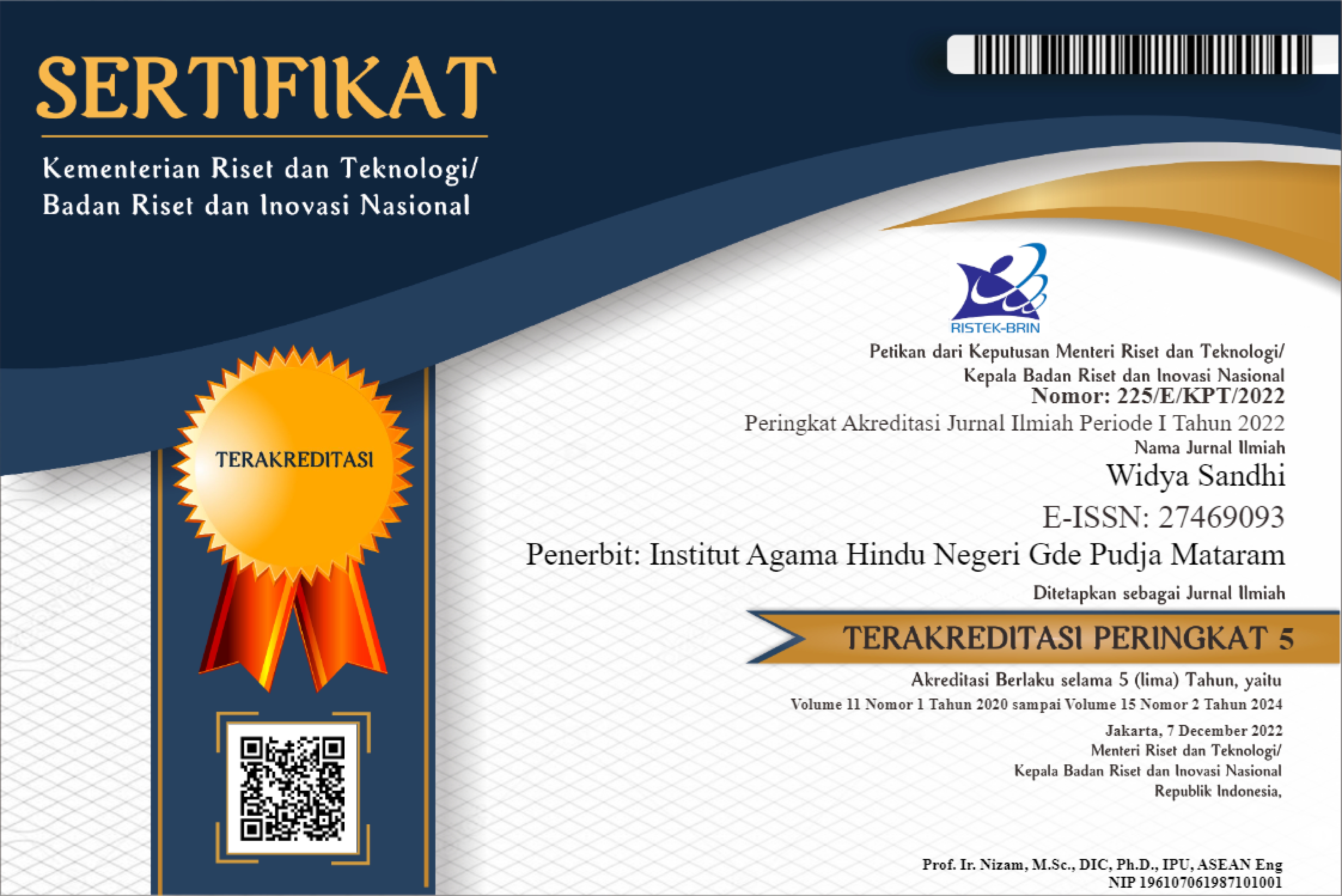PROSES PENYULUHAN AGAMA HINDU DI SATUAN KERJA PERANGKAT DAERAH PROVINSI NTB
Abstract
Religious counseling is a form of unit activities that have strategic value, especially in carrying out of functions of the expedite implementation development in the field of religion. Religious counseling of Hinduism is in fact a process of education that aims to enhance the awareness and behavior (knowledge, attitude and skill) communities into a better direction.
Descriptive research method is used in this research. Theoretical basic are SMCRE theory, the theory of innovation and the theory of rasa. The technique of data collection in this research is survey method, observation, in-depth interviews and documentation. The results of research discover that process counseling of Hinduism is moderator opening the event, introduced the counselor and the message to be conveyed. Than counselor the convey the message of Dharma Wacana method for 15 minutes. Moderator guides the discussion (Dharma Tula) for 40 minutes related to the message presented by give the participants an opportunity to ask or give feedback. Next counselor is given the opportunity to answer or provide clarification on questions and responses of participants
References
Barlingay, 2007. Indian Aesthetic Theory, Bali Nagar : Printworld Ltd
Budyatna & Ganiem, 2012. Teori Komunikasi Antarpribadi. Jakarta : Kencana Prenada Media Group
Bungin, Burhan. 2006. Sosiologi Komunikasi. Jakarta : Kencana Prenada Media Group
Cangara, Hafied. 2013. Perencanaan dan Strategi Komunikasi. Jakarta : Raja Grafindo Persada
Cudamani. 1989. Pengantar Agama Hindu Untuk Perguruan Tinggi. Jakarta : Yayasan Dharma Sarathi
Effendy, Onong Uchjana. 2000. Dinamika Komunikasi. Bandung: Remaja Rosdakarya.
Effendy, Onong Uchjana. 1985. Ilmu Komunikasi Teori dan Praktek. Bandung: Remadja karya CV Bandung
Littlejohn & Foss. 2014. Teori Komunikasi, Theories Of Human Communication. Jakarta : Salemba Humanika
Ngurah, I Made dkk. 1999. Pedoman Pendidikan Agama Hindu. Surabaya: Paramita
Rakhmat, Jalaluddin. 2012. Metode Penelitian Komunikasi. Jakarta. Remaja Rosdakarya
Ratna, Nyoman Kutha. Metodologi Penelitian, Kajian Budaya dan Ilmu Sosial Humaniora Pada Umumnya. Yogyakarta : Pustaka Pelajar
Riduwan. 2006. Metode dan Teknik Menyusun Tesis. Bandung: Alfabeta
Rakhmat, Jalaluddin. Metode Penelitian Komunikasi. Bandung : Remaja Rosdakarya
Rakhmat, Jalaluddin. 2013. Psikologi Komunikasi. Bandung : Remaja Rosdakarya
Ruslan, Rosady. Metodologi Penelitian Public Relations dan Komunikasi. Jakarta: Raja Grafindo Persada
Severin & Tankard. 2011. Teori Komunikasi, Sejarah, Metode, dan Terapan di Dalam Media Massa. Jakarta: Kencana Prenada Media Group
Sugiyono. 2009. Metode Penelitian Pendidikan. Bandung: CV. Alfabeta
Sarwono, Sarlito Wirawan. 2013. Teori-Teori Psikologi Sosial. Jakarta: Raja Grafindo Persada
Sura, I Gede dkk. 1991. Agama Hindu Sebuah Pengantar. Denpasar: Kayumas Agung
________ 1996. Buku Petunjuk Pelaksanaan Teknis Pembinaan Umat Hindu. Ditjen
Bimas Hindu dan Budha
Departemen Agama RI.
Tim Penyusun. 2007. Pedoman Tenaga Pembina(Yang Disempurnakan). Jakarta :
Mitra Abadi Press
West & Turner. 2008. Pengantar Teori Komunikasi, Edisi 3. Jakarta: Salemba Humanika.
Wirdiata, I.M.S. 2009. ”Analisis Efektifitas Penyuluhan Sebagai Strategi Peningkatan Pemahaman Ajaran Agama Bagi Pns Hindu Di Satuan Kerja Perangkat Daerah (SKPD) Propinsi NTB” (Skripsi). Mataram : STAHN Gde Pudja Mataram
Widana, I Nyoman Murba. 2007. Tuntunan Praktis Dharma Wacana Bagi Umat Hindu. Surabaya: Paramita
Yasa, I Wayan Suka. 2007. Teori Rasa : Memahami Taksu, Ekspresi & Metodenya. Denpasar : Widya Dharma
Yasa, I Wayan Suka. 2009. Rasa : Daya Estetik-Religius Geguritan Sucita. Denpasar : Sari Kahyangan Indonesia
Referensi internet
http://en.wikipedia.org/wiki/Religiosity. Diakses 1 April 2015
http://www.change.freeuk.com/learning/socthink/religiosity.Diakses 1 April 2015
http://sadharanikarantheory.blogspot.com/2008/12/sadharanikaran-model-and-aristotles.html. Diakses 1 April 2015
http://www.nepjol.info/index.php/BOHDI/article/viewArticle/2814.tgl 25 Mei 2015
http://www.nepjol.info/index.php/BOHDI/article/viewArticle/2877. tgl 25 Mei 2015
Jurnal Ilmu Dakwah Vol.7No.21/Edisi Januari–Juni2013/ Firman_Nugraha_ PENYULUHAN_AGAMA_TRANSFORMATIF_SEBUAH_Model_Dakwah/ pdf, diakses 25 Mei 2015
Rogers, E.M. dan Shoemaker, F.F., 1971, Communication of Innovations, London: The Free Press.
http://www.the-essayist.org/2013/10/natyashashtra/. diunduh 28 mei 2015
http://www.ntbprov.go.id/hal-sejarah-nusa-tenggara-barat.html, diakses 18 Des 2015
http://www.kemendagri.go.id/pages/profil-daerah/provinsi/detail/52/nusa-tenggara-barat
http://id.wikipedia.org/wiki/Komunikasi_massa
https://id.wikipedia.org/wiki/Satuan_Kerja_Perangkat_ Daerah

This work is licensed under a Creative Commons Attribution-NonCommercial-ShareAlike 4.0 International License.
Authors who publish with this journal agree to the following terms:
- Authors retain copyright and grant the journal right of first publication with the work simultaneously licensed under a Creative Commons Attribution-ShareAlike 4.0 International License. that allows others to share the work with an acknowledgment of the work's authorship and initial publication in this journal.
- Authors are able to enter into separate, additional contractual arrangements for the non-exclusive distribution of the journal's published version of the work (e.g., post it to an institutional repository or publish it in a book), with an acknowledgment of its initial publication in this journal.
- Authors are permitted and encouraged to post their work online (e.g., in institutional repositories or on their website) prior to and during the submission process, as it can lead to productive exchanges, as well as earlier and greater citation of published work (See The Effect of Open Access).






.jpg)




